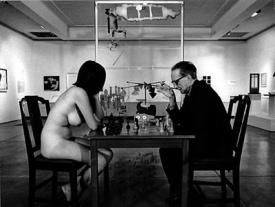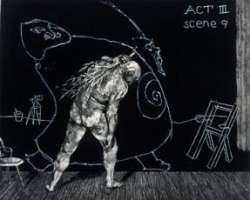
Thinking, for a moment, about a particularly difficult human-computer interface problem with a dynamic set of requirements… which I suppose is any problem of this kind. The problem itself points the limitations of representation; as the solution forms, life moves on. The problem can also be expressed in terms of data and databases– the only data that exists in a database is the data that’s entered; and it doesn’t change unless energy is expended to change it. It’s a snapshot of a moment. Certain problems like Search are amenable to employing robots for the gathering of data. But what we think we’re doing when we search for something continues to change.
There’s a little book by James P. Carse that I return to now and again. It’s called Finite and Infinite Games, I’ve reproduced the entire first chapter below:
There are at least two kinds of games. One could be called finite, the other infinite.
A finite game is played for the purpose of winning, an infinite game for the purpose of continuing the play.
We play a series of finite and infinite games in the pursuit of the infinite game of continuing the play. The rather large portfolio carved out by interaction and human factors designers plays along this edge– the finitude of the designed object against the infinity of its use within a form of life. William Gibson expressed it simply as: “the street has its own use for things…” The street is a particularly rough game whose object is primarily to continue the play.
Ludwig Wittgenstein, in the book Philosophical Grammar describes how the fundamentals of an interaction (a finite game) relate to its expression in a system of representation. It’s a succinct story about how the front-end relates to the back-end of a certain kind of web application.
Let us imagine that chess had been invented not as a board game, but as a game to be played with numbers and letters on paper, so that no one had ever imagined a board with 64 squares in connection with it. And now suppose someone made the discovery that the game corresponded exactly to a game which could be played on a board in such and such a way. This discovery would have been a great simplification of the game (people who would earlier have found it too difficult could now play it). But it is clear that this new illustration of the rules of the game would be nothing more than a new, more easily surveyable symbolism, which in other respects would be on the same level as the written game. Compare with this the talk about physics nowadays not working with mechanical models but “only with symbols”.
Imagine what the Network would look like if it were only composed of finite games. Now imagine a Network in real time composed of both finite and infinite games. In building an application for this Network, would you use the same techniques with an infinite game as you would for a finite game? How would they differ?
Here’s another fragment from Carse:
Although the rules of an infinite game change by agreement at any point in the course of play, it does not follow that any rule will do. It is not in this sense that the game is infinite.
The rules are always designed to deal with specific threats to the continuation of play. Infinite players use the rules to regulate the way they will take the boundaries or limits being forced against their play into the game itself.
The rule-making capacity of infinite players is often challenged by the impingement of powerful boundaries against their play– such as physical exhaustion, or the loss of material resources, or the hostility of nonplayers, or death.
The task is to design rules that will allow the players to continue the game by taking these limits into play– even when death is one of the limits. It is in this sense that the game is infinite.
This is equivalent to saying that no limitations may be imposed against infinite play. Since limits are taken into play, the play itself cannot be limited.
Finite players play within boundaries; infinite players play with boundaries.
There’s a sense in which the hyperlink allows the infinite to be contained within the finite. Or rather, it extends the finite into the infinite. In an open Network, hypertext links to hypertext, which links to hypertext. And by the word “text” we refer to all media types. The “hyper” in “hypertext” means the referent is not present, but directions to its location are ready to hand. (The signs within a language work this way, although sometimes the directions can be ambiguous and aren’t always legible.)
The hyperlink embedded in a static document system originally opened this door. But the static document is giving way to the dynamic document and a series of hypertext fragments populating a stream of information and thought objects moving in real time. Described as a kind of stream culture, our tool set to engage with the possible set of streams is remarkably absent. Somewhere a stream is emitting the information we need to know, but can’t find with our standard set of queries. Instead we gather around to argue whether or not it’s actually a stream we’re standing in, and whether our feet are actually wet.
In thinking about building a tool for the stream culture, will the techniques developed for use in finite games be sufficient? — or will we need to crack open a bottle of new wine?
Comments closed“Nor do people put new wine into old wineskins; otherwise the wineskins burst, and the wine pours out and the wineskins are ruined; but they put new wine into fresh wineskins, and both are preserved.”



